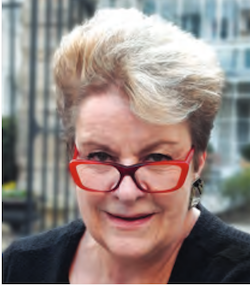Reid Hall: A Historical Perspective
Brunhilde Biebuyck, Administrative Director of Reid Hall, talks about the center's historic evolution and the creation of the Reid Hall History website.
This interview originally appeared in the Paris Center's Annual Report 2018-19.

Reid Hall has been part of Columbia since 1964 and you have been part of Reid Hall for 35 of those 55 years. How would you describe its evolution?
When I first came to Reid Hall in 1984, it had undergone an important transition from what it was in the fifties: an American study center, a residence, and a dining and social facility serving different university groups and foreign visitors. By 1984, it had become the administrative headquarters for several American study abroad programs, including Columbia’s. In line with the very principles of study-abroad, immersion was the mot d’ordre. Students were encouraged (then required) to speak French, live with French families; all classes were held in French, visits to cultural centers and other regions of France were organized, and exchange agreements with French academic and cultural institutions were established. In those heydays of study abroad, Reid Hall attracted as many as 800 students per year and the largest cohorts came through the Columbia undergraduate programs. While students had “the time of their life,” the American universities that sent them abroad were far removed from their activities. At Columbia itself, few people really understood what Reid Hall was about; we were an outpost with all the liberties and issues outlying institutions face with respect to their main organization.
The real turning point took place in 2010 when Reid Hall was selected as the location of Columbia Global Centers | Paris. Since then, it has become an authentic extension of Columbia’s campus, both from administrative and pedagogical points of view. Today, Reid Hall has a strong tripartite mission: an undergraduate and several Masters programs in which classes are taught by both French and Columbia faculty; a dynamic public program that leverages not only Columbia’s intellectual resources but also French academic and cultural know-how, and an innovative research center attracting Columbia faculty and artists from all parts of the world. Administratively, Reid Hall now benefits from the powerful resources of the university, from its fiscal units, its communications and internet teams, its vast library and digital data bases, to its expertise in facilities management and maintenance. Most importantly, the university has recently made possible Reid Hall’s long-deferred modernization and refurbishment.
While Columbia is now squarely rooted at Reid Hall, study abroad programs from Smith, Hamilton, Sarah Lawrence, Vassar-Wesleyan, and Sweet Briar still pursue their activities on site. Several American cultural associations and the Association Française des Femmes Diplomées des Universités (the oldest member of Reid Hall) continue to be headquartered here.
Reid Hall remains an educational, social, and cultural hub that connects students to all facets of Parisian life. Scholars from all parts of the world collaborate and engage in intellectual exchange through teaching, conferences, concerts, performances, and art exhibits. Today, we can proudly say that Reid Hall’s mission has been carried forward even more strongly, with loftier ambitions, and even greater attention to the many questions that face our world. Columbia has transformed this “relic of old Paris” into, in the words of a recent student, “a real gem.”

A passion of yours is exploring the Reid Hall’s history. How did this interest develop and what will it lead to?
Reid Hall’s special spirit has been shaped by its many layers of activities, which have never been explored in depth. Yet, it was the first setting for French-American cultural and artistic exchange and the premier site for study abroad programs in the forties and fifties. In addition, it was a hall of fame featuring women thought-leaders, artists, activists, educators, and administrators who worked, spoke, or acted within its walls. Much of their history remains unwritten, but these women were movers and shakers willing to cross borders and forge parallel power structures. Many were, like the Reids, women of wealth and prominence, and they paved the way for others through the educational opportunities they created and supported. Since 1893, when Elisabeth Mills Reid established a Girls’ Art Club at 4 rue de Chevreuse, it has operated as a French-American center and benefitted from the intellectual, cultural, and savoir faire of both countries. Reid Hall is neither completely American nor completely French, nor even the conjugation of the two. It is a third space, a transformative site through which so many students, artists, faculty have experienced changes in their personal and professional lives and thought processes. For all these reasons, the website dedicated to Reid Hall’s history will yield a rich and compelling tale.
